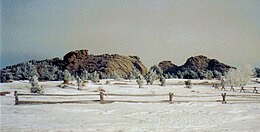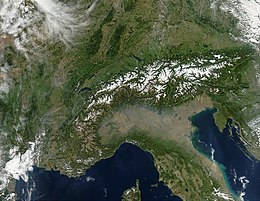mountain range
A mountain range is a series of high mountain peaks or a contiguous mountain range within a larger mountain range . The term is also used for elongated fold mountains with several parallel chains (chain mountains). While the terms mountain range or mountain range are common in the high mountains , in the low mountain range one speaks more of a mountain range or ridge, or in the hilly country of a range of hills. Elongated mountain ranges occur most frequently in orogen types of the fold mountain type (unfolding due to lateral pressure) and the ceiling mountain (thrusting of thin rock packages). Other types of mountains such as quarry or eyrie mountains or rump mountains hardly form parallel chains . If, on the other hand, a rump mountain is eroded to form a high plateau , progressive devastation can also give rise to mountain chains.
Formation of parallel mountain ranges
The chain-like arrangement of the peaks and the formation of long, jagged mountain ridges - also called Sierra (saw) in Spanish - is a result of the common formation by mountain-forming forces . The often linear structure is not only related to the direction of these shear forces and the resulting mountain folds but also to geological fault lines in the upper crust of the earth that run between individual mountain ranges. In these fault zones , the partially crushed rock is easier to erode, so that larger river valleys form there. These so-called long valleys additionally reinforce the trend towards the formation of parallel mountain ranges among young orogenous.
The fact that fold mountains (e.g. the Cordilleras ) tend to form almost parallel chains is related to their rock structure and the shear forces of the plate tectonics . The upwardly pressed rock packets are either igneous deep rock , which are easily deformable due to their warmth, or sediments or metamorphic rocks with little solid structure deposited in the synclines . Therefore the orogen forms folded layers, bent over from the horizontal position and pushed together laterally. The longitudinal extension of the folds is perpendicular to the direction of the sideshift. Similarly, the are About Schiebungs folding a ceiling mountains (eg. As the central Alps ) shaped.
The fold, chain or ceiling mountains that can be found around the world may have arisen at different times in the history of the earth, but are morphologically similar to one another at the stage of development. Harder rocks form continuous ridges or ridges that follow the stroke of the layers and folds. The chains or backs that are formed are therefore approximately parallel to one another. They are only interrupted by short, mostly narrow transverse valleys , which often emerge as a breakthrough valley. In the course of the earth's history, erosion by water, ice and wind has the effect that the highest points of the mountain ridges are removed the fastest and that individual peaks or summit chains are modeled. In between there are cuts that, depending on the altitude and the rock, form sharp-edged gashes , or gentler mountain passes and saddles .
Predominant rocks and mountain shapes

Ceiling or fold mountains with their roughly parallel mountain ranges essentially have a uniform geological age, but can consist of several types of rock . Granitic rocks, gneiss and metamorphic slate predominate in the Central Alps , while the Limestone Alps emerged to the north and south of them . The Northern Limestone Alps are again the soft flysch mountains and the Molasse zone in front.
The type of rock shapes the appearance of the mountain ranges very clearly, because the erosion leads to very different shapes depending on the rock hardness and petrological structure. In addition to altitude and climate, the stratification of the rock, slope and exposure , water types and geological fault lines also play a role . The rugged walls (e.g. the Dolomites ) and their enormous cones of rubble are typical of hard rock massifs . In contrast, with flysch or slate, gentle mountain shapes and peaks form because the rock is hardly permeable to water, but is easily deformable.
See also
literature
- Knowledge today: geology . Kaiser-Verlag, Firenze / Klagenfurt 1995
- The geological structure of Austria . Federal Geological Institute, Springer-Verlag Vienna / New York
- PanGeo, Earth Sciences in Austria . Conference proceedings, 200 p., Sessions on Neogen, TRANSALP I and II. Univ. Salzburg 2005
- Fischer-Lexikon Geographie , p. 101–129, Frankfurt 1959
- Large world atlas, encyclopedic part (mountain formation, folds and fractures, circulation of rocks). Edited by ÖAMTC, Vienna ~ 1980
- André Cailleux: The Unknown Planet: Anatomy of the Earth . Kindler's University Library, Munich 1968, chap. 1 and 3
- Mountains , in: Lueger, Otto : dictionary of technology and its auxiliary sciences , Vol. 4 Stuttgart, Leipzig 1906, pp 316 - 317 .

